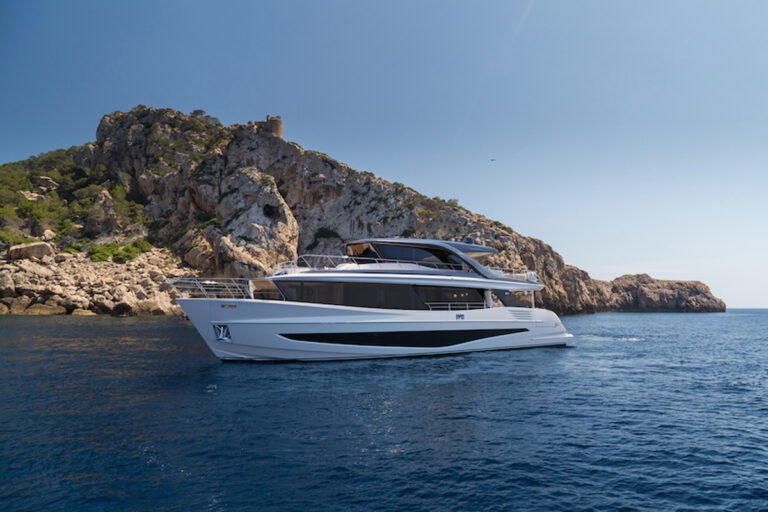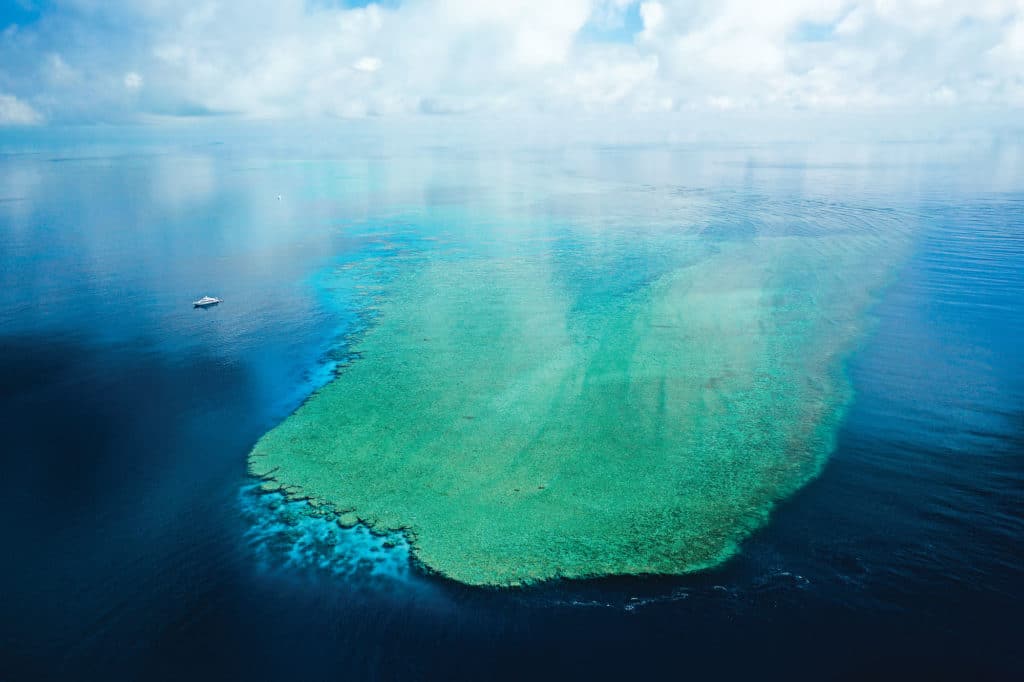
Cairns, Australia, feels like a modern-day pioneer town. Nestled between two of the world’s great wildernesses, it strikes a balance between beachy normalcy and something otherworldly. Directly to the north and west lies the Outback, an arid moonscape so sparsely populated that in 1993, when a mysterious explosion occurred, some speculated that it was an atomic bomb set off by a Japanese murder cult, and only a handful of gold prospectors and cattlemen even knew it was happening in the moment. To the east lies the mighty Pacific Ocean and the Great Barrier Reef, a living organism so large, it’s visible from outer space. At night in Cairns, flying foxes hang in the trees that line the sidewalk, fruit bats the size of well-fed Chihuahuas, screeching and flapping their wings as revelers hop blithely from waterfront bar to waterfront bar 10 feet below. The people are blithe because the ever-present live rock ‘n’ roll and blues music drowns out the bats’ screeches—plus beer. In Cairns the rule is never gaze up looking for answers, instead keep your eyes on the path forward.
This is where I met the charter yacht Aroona, a 70-foot Outer Reef that is as singular as the port it calls home.
As I arrived at Yorkeys Knob Marina 15 minutes north of the Cairns central business district, I was greeted by warning signs: a saltwater crocodile with its mouth open and the words, “Do not go in the water.” Considering the Australian folk logic that “99 out of 100 shark attacks aren’t fatal, but 99 out of 100 croc attacks are,” suffice it to say that Yorkeys Knob is an excellent place to have a nice, big boat from which to enjoy the water.
And luckily, I did. Aroona is built for adventure. The boat offers an array of itineraries centered around fishing, diving, kitesurfing—you name it. Indeed, Aroona served as the mothership for a band of kitesurfers who, in 2015, broke the world record for longest kitesurfing expedition.
For charterers looking for thrills, Aroona is nothing less than a nautical Humvee, locked and loaded for the promised land.
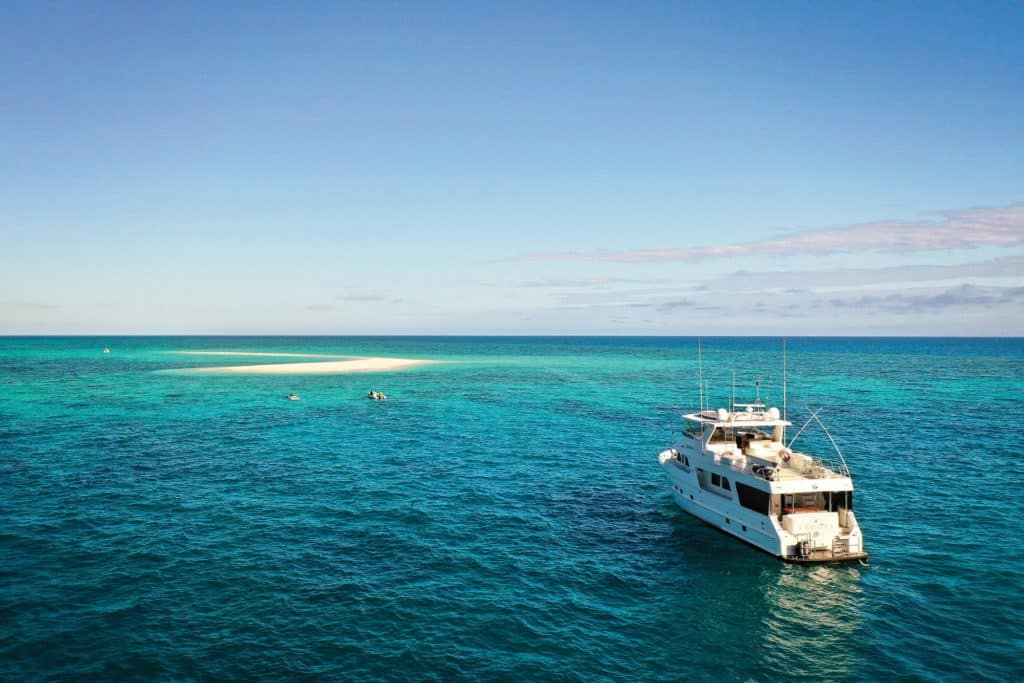
The crew is trained in all aspects of the reef and ways to enjoy it. Capt. Ross Miller sets the tone. A slender man with shaggy brown hair and a lilting Aussie accent, he doesn’t at first appear to be the swashbuckler that he is. However, on the first day, he casually mentioned a recent hang-gliding accident. At first, I thought he was joking—because, seriously, who hang glides?—but he had been knocked unconscious when he hit his head on one of the aircraft’s bars during a race. He was rather, let’s say, surprised when he regained consciousness while plummeting Icarus-style from the sky. Thankfully, he managed to regain his wits (and his lift and drag) fast enough to escape with a broken foot. The offhanded nature of the tale he told led me to believe it was one of many in a life saturated with stories that will someday impress his grandchildren.
The crew includes a dive instructor, a stewardess who doubles as a spearfish guide, and a chef whose first offering was ceviche and ripe fruits, soon to be followed by Asian dishes with spices that sizzled and popped. I took home the chef’s recipe for salmon because it was probably the best I’ve ever had. (Cook it hot and quick, skin side down, using wax paper with something heavy on top, and thank me later.)
After meeting the captain and crew, I stepped aboard Aroona alongside Ron Martin, and our journey began in earnest. We shoved off in the afternoon and chugged toward Fitzroy Island, where we dropped anchor just before nightfall. Big Fitzroy is a patch of rainforest hovering above the reef like a puffy olive-green cloud. It has a resort on the beach. As we sat in the cockpit enjoying a cold beer and contemplating the next day’s dive, the laughter of children mingled with the sound of the ocean gently slap-slap-slapping on the hull in the inky darkness. Thousands of minnows danced in the purple-and-green light below our transom. I retired to the forepeak guest and had the best sleep I’d had in days—jet lag always messes me up.
In the morning, I awoke to the steely clatter of the anchor being pulled in. After coffee, it was time to squeeze into a 3 mm wetsuit and make my way to the swim platform to survey the water over Milne Reef. It was grayer than I’d expected, much more like the northern Atlantic I’d grown up with than the turquoise green I’d seen in photos. With that grayer water of course comes less visibility, which makes me think of sharks. And this is when an old childhood fear crept in. Starting when I was 5, I began watching Jaws the way most tots now watch Frozen. And while time in the water with sharks of varying species has dulled that irrational fear, I still have a healthy respect for them—and in particular Australian sharks, because, c’mon, don’t they just seem a bit bigger and hungrier?
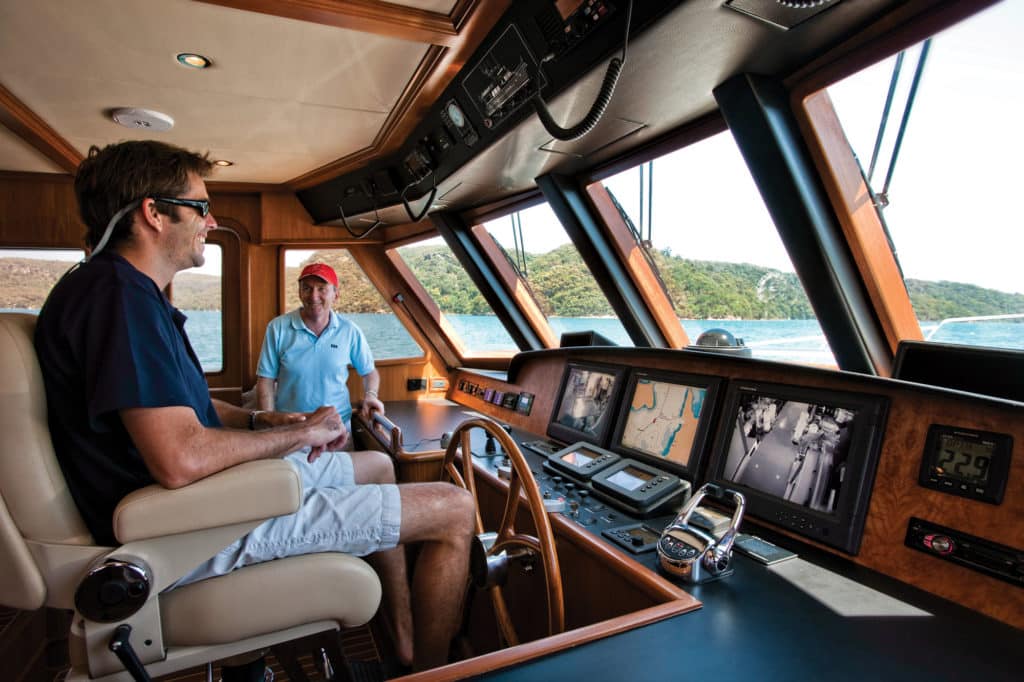
As I was telling myself it would be fine, a whale breached 15 feet off Aroona’s transom and blew a stream of mist straight up in the air. And then it did it again. And again and again, timed with the rhythm of the waves.
Wait, that was no whale … I had just become acquainted with “whale bommie.” In Australian vernacular, a bommie is a wave that breaks well offshore onto a reef. Some bommies are famous as big-wave surf spots. This particular bommie has a break that looks like a whale spouting. It was a surreal scene, one that did nothing to dispel the pangs of shark doubt I was feeling. In that moment, the ocean just seemed so utterly, impossibly huge—and I had a feeling I was too small. But, as my mother always told me, you only go round once. So, I followed the dive instructor’s lead and plopped into the abyss. I kicked around a bit and acclimated to breathing underwater; it had been some time since I had last dived. When I was ready, I followed the instructor down into the dark, cold water. The hiss of the bommie above dampened as we dived deeper, spiraling our way around the coral head. We kicked our way over to a small sand flat, and I saw … a shark. It was a 5-foot-long reef shark—not Jaws or a marauding tiger shark with a belly full of California license plates, just a sleek little fish minding its business in its own home. We kicked onward.
The bommie itself was a totem pole of coral, jutting up from the matte navy-blue water in quilted reds, greens and browns. Gorgonian sea fans shot out into the water with rugged delicacy, and thickets of staghorn coral provided a playground and protection for a rainbow of little fish.
A Maori wrasse floated by, bigger than I was, with its unsettlingly humanlike countenance wholly unperturbed, if it even noticed us at all. It might as well have been saying, “Beat it, geek.”
Soon, I felt a chill expanding in my torso. The water was unseasonably cool at about 72 degrees, and even with my wetsuit, my core temperature began to dip. I headed up to the surface for more hot coffee and heaping plates of bacon and eggs.
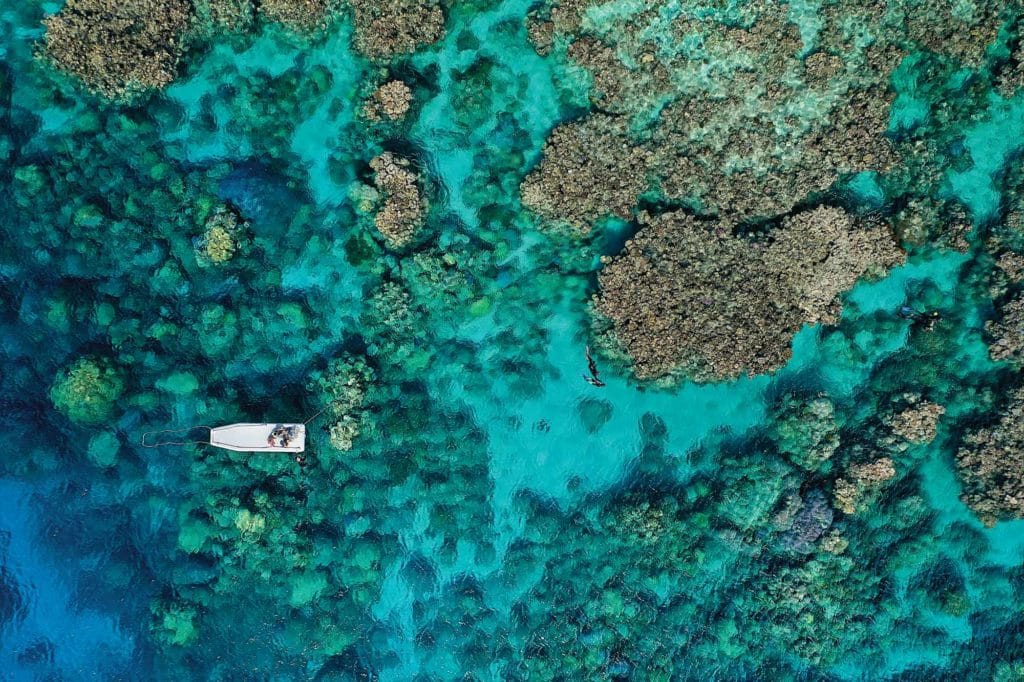
Eat. Sleep. Repeat. I awoke again to the anchor clanking in and engines roaring to life. Our second day of diving was on a reef formation known as the Three Sisters. The three bommies here were swarmed with thick schools of reef fish: snappers and sweetlips, surgeonfish and garden eels. The waters teemed with all the denizens of the Great Barrier Reef’s shallow waters. The Three Sisters also acts as a gateway of sorts to deeper water, and huge pelagics often pass through en route to some of the greatest sport-fishing grounds on Earth, probably looking for a snack.
It’s no secret that Australian waters are a murderer’s row of animals that could kill you. They don’t necessarily want to; it’s just that sometimes they do. Consider the scene a shoulder shrug from Mother Earth. Crocs and great whites, box jellyfish and stonefish, even the cute little blue-ringed octopuses that populate Sydney Harbour—about the size of a human thumb and deadly as hell.
That day at Three Sisters, we happened upon one of the most deadly animals these waters have to offer: the unassuming cone snail. The largest cone snails are about the size of a salt shaker, and their shells come in a dazzling variety of colors. This one happened to be blah beige. It was tucked onto a small ledge on the reef, and I would have swam right by it had the dive instructor not stopped with his sketch pad to scribble a face with X’s for eyes and “Don’t touch! Cone snail!” I just stopped and stared, steering clear of its hollow needle that delivers toxic venom. Floating in the abyss, 50 feet down and breathing canned air, I stared at this massively unimposing animal and marveled at death’s insidious ability to be so terribly mundane. I shook my head and kicked on.
The current was strong that day, and by the time we headed to the surface, we had been dragged from Aroona by at least a few hundred yards. The captain spotted us and sent the crew to come snatch us up. The tender was probably doing 25 knots coming toward us, but it felt like 5. Floating there in a hundred feet of water, 20 miles offshore of the northeastern Australian coast … there’s no feeling in the world like feeling like bait.
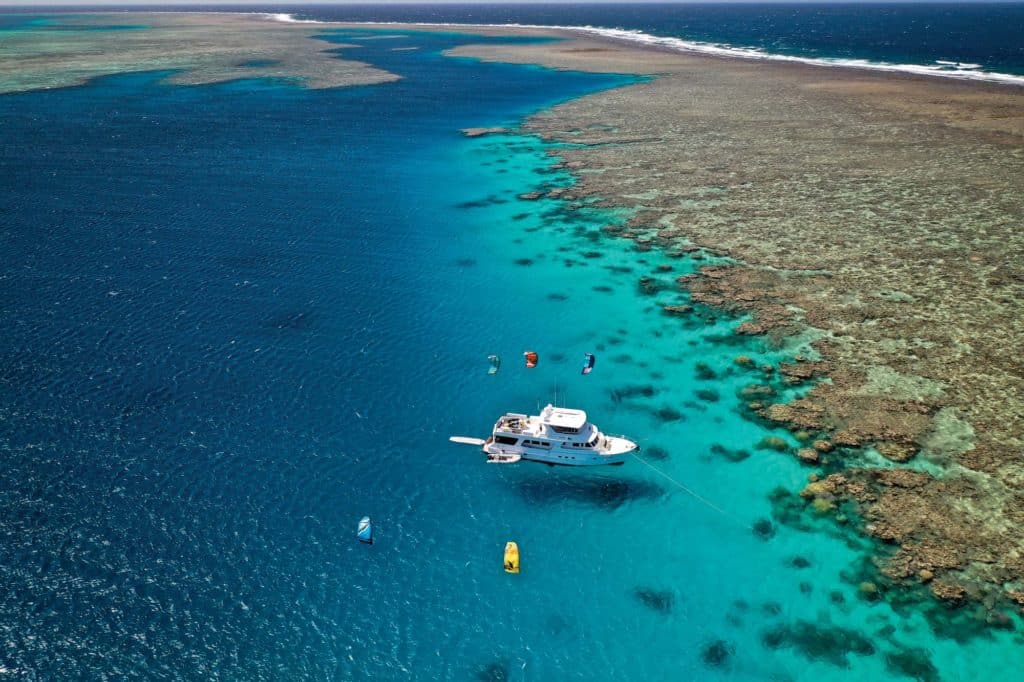
Eat. sleep. repeat. The next day, we chugged off to a ledge to do some spearing. The weather had warmed up, and the ocean was brimming with life. Turtles bobbed on the surface like apples in a basin. Dolphins played in our wake for a half-hour, eventually making their way to our bow, jumping up so close that I could nearly touch them from the foredeck with my arms dangling overboard. At one point, a whale—an actual whale this time, a humpback—surfaced about 50 yards off, and smashed its fluke onto the water’s surface, shooting spray up into the gulls that fussed overhead like a squadron of highly aggrieved mothers-in-law.
An hour later, I was in the RIB with spears and fins, zipping over to the fishing spot. We got skunked because fish ain’t stupid. While the dive spots full of fish are protected zones, the spearfishing spot was not. And thus, we spent an hour chasing a lone coral trout across the reef, watching it dip in and out of holes and change colors to blend in with its surroundings.
Later, we dropped anchor off a deserted island, like the kind you might see in a New Yorker cartoon. It was nothing but a lonely spit of sand surrounded by endless miles of ocean. We loaded up the RIB again, this time with ice-cold cans of beer, and headed off to explore it. As the day grew dark, I sat in the sand with my feet in the water and cracked open my beer. Directly ahead of me on the horizon, the sun was a fiery tangerine orb about to douse itself in a Champagne-colored sea. The indigo sky around it shimmered as it turned the color of orange and cherry sherbet.
I breathed the salty air deeply and felt so keenly grateful, so very alive. I welcomed the night and the dreams that come with it.
Take the next step: aroonaluxuryboatcharters.com.au







